BMGT001: Analysis of Authoritative Command in Conflict Resolution
VerifiedAdded on 2023/06/08
|8
|1844
|164
Report
AI Summary
This report critically examines the authoritative command style of conflict resolution within organizations, arguing that while it offers a short-term solution, it often fails to address the root causes of conflict and can lead to negative outcomes such as employee dissatisfaction and decreased cooperation. The report contrasts this approach with collaborative methods and highlights the importance of understanding and addressing the underlying issues in conflict situations. The analysis draws upon various academic sources to support its claims and provides insights into the limitations of relying solely on formal authority in managing workplace disputes. The student's reflection builds on a group presentation, incorporating alternative viewpoints and research to support a comprehensive argument.
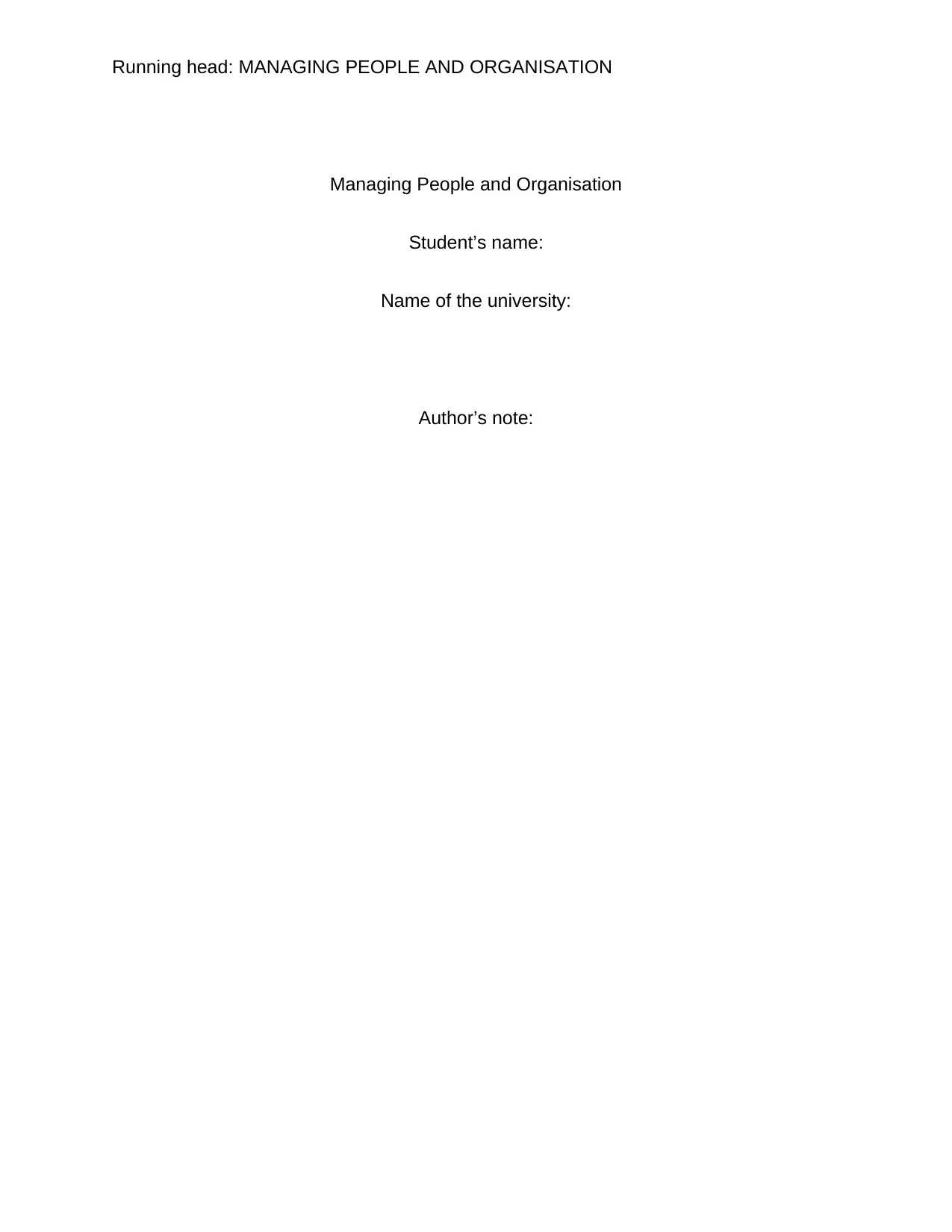
Running head: MANAGING PEOPLE AND ORGANISATION
Managing People and Organisation
Student’s name:
Name of the university:
Author’s note:
Managing People and Organisation
Student’s name:
Name of the university:
Author’s note:
Paraphrase This Document
Need a fresh take? Get an instant paraphrase of this document with our AI Paraphraser
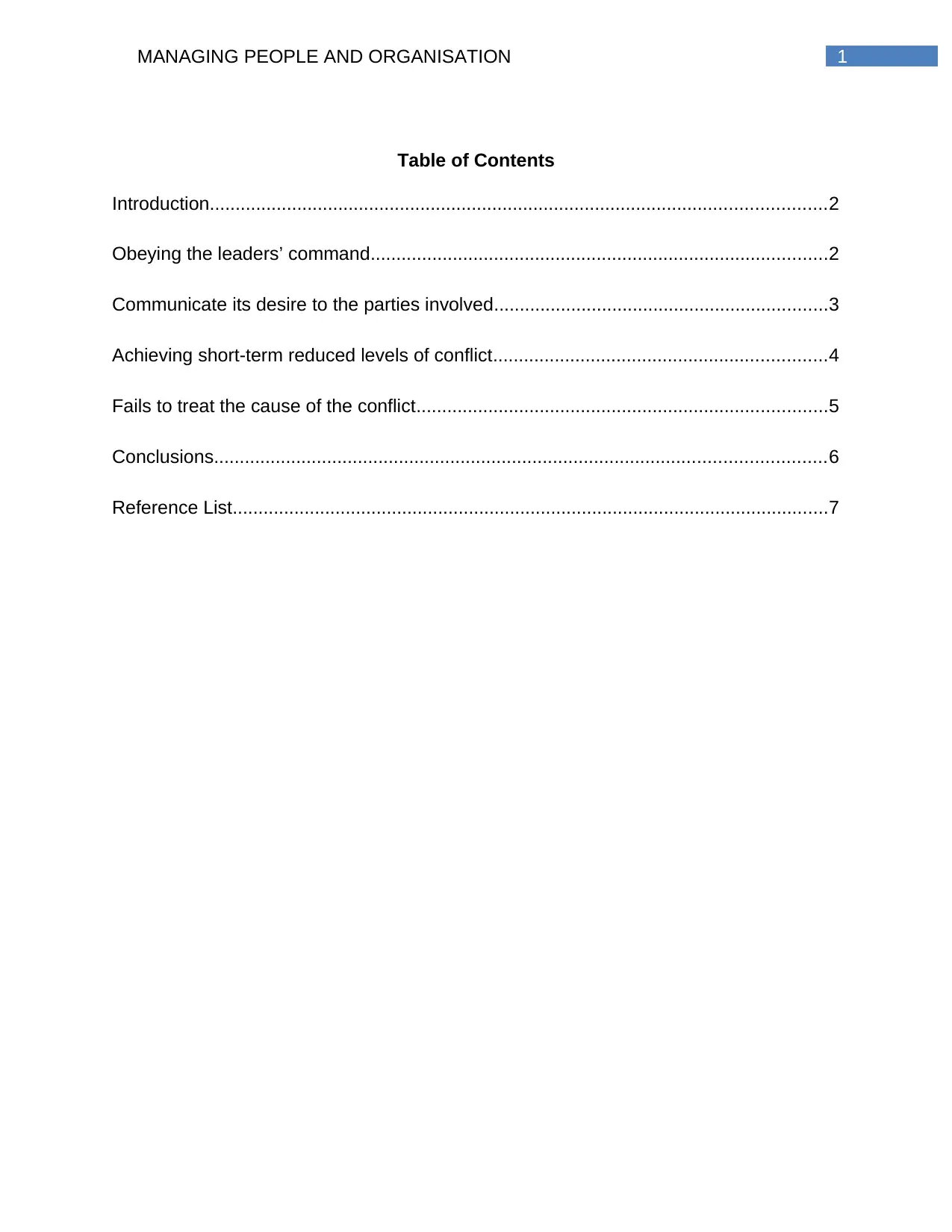
1MANAGING PEOPLE AND ORGANISATION
Table of Contents
Introduction........................................................................................................................2
Obeying the leaders’ command.........................................................................................2
Communicate its desire to the parties involved.................................................................3
Achieving short-term reduced levels of conflict.................................................................4
Fails to treat the cause of the conflict................................................................................5
Conclusions.......................................................................................................................6
Reference List....................................................................................................................7
Table of Contents
Introduction........................................................................................................................2
Obeying the leaders’ command.........................................................................................2
Communicate its desire to the parties involved.................................................................3
Achieving short-term reduced levels of conflict.................................................................4
Fails to treat the cause of the conflict................................................................................5
Conclusions.......................................................................................................................6
Reference List....................................................................................................................7
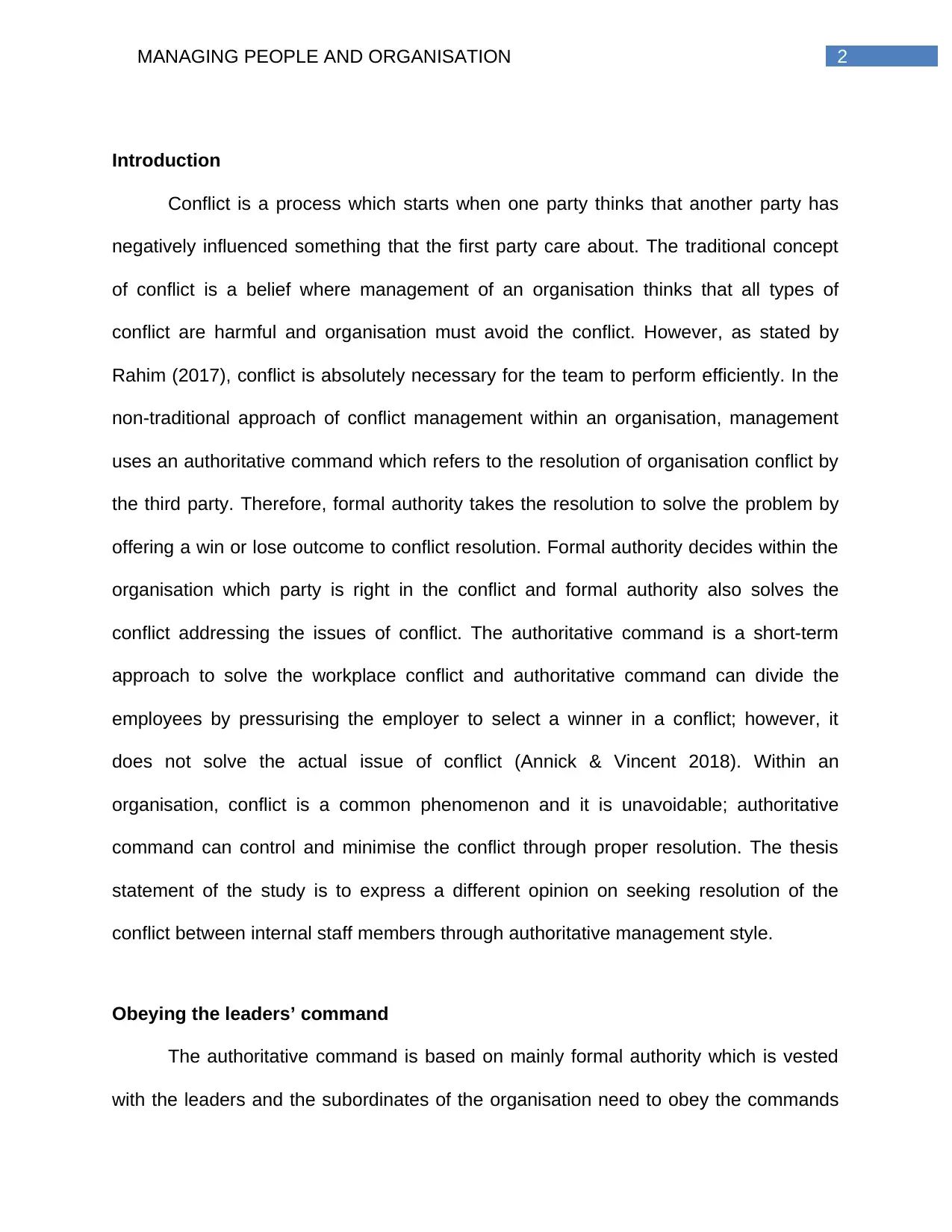
2MANAGING PEOPLE AND ORGANISATION
Introduction
Conflict is a process which starts when one party thinks that another party has
negatively influenced something that the first party care about. The traditional concept
of conflict is a belief where management of an organisation thinks that all types of
conflict are harmful and organisation must avoid the conflict. However, as stated by
Rahim (2017), conflict is absolutely necessary for the team to perform efficiently. In the
non-traditional approach of conflict management within an organisation, management
uses an authoritative command which refers to the resolution of organisation conflict by
the third party. Therefore, formal authority takes the resolution to solve the problem by
offering a win or lose outcome to conflict resolution. Formal authority decides within the
organisation which party is right in the conflict and formal authority also solves the
conflict addressing the issues of conflict. The authoritative command is a short-term
approach to solve the workplace conflict and authoritative command can divide the
employees by pressurising the employer to select a winner in a conflict; however, it
does not solve the actual issue of conflict (Annick & Vincent 2018). Within an
organisation, conflict is a common phenomenon and it is unavoidable; authoritative
command can control and minimise the conflict through proper resolution. The thesis
statement of the study is to express a different opinion on seeking resolution of the
conflict between internal staff members through authoritative management style.
Obeying the leaders’ command
The authoritative command is based on mainly formal authority which is vested
with the leaders and the subordinates of the organisation need to obey the commands
Introduction
Conflict is a process which starts when one party thinks that another party has
negatively influenced something that the first party care about. The traditional concept
of conflict is a belief where management of an organisation thinks that all types of
conflict are harmful and organisation must avoid the conflict. However, as stated by
Rahim (2017), conflict is absolutely necessary for the team to perform efficiently. In the
non-traditional approach of conflict management within an organisation, management
uses an authoritative command which refers to the resolution of organisation conflict by
the third party. Therefore, formal authority takes the resolution to solve the problem by
offering a win or lose outcome to conflict resolution. Formal authority decides within the
organisation which party is right in the conflict and formal authority also solves the
conflict addressing the issues of conflict. The authoritative command is a short-term
approach to solve the workplace conflict and authoritative command can divide the
employees by pressurising the employer to select a winner in a conflict; however, it
does not solve the actual issue of conflict (Annick & Vincent 2018). Within an
organisation, conflict is a common phenomenon and it is unavoidable; authoritative
command can control and minimise the conflict through proper resolution. The thesis
statement of the study is to express a different opinion on seeking resolution of the
conflict between internal staff members through authoritative management style.
Obeying the leaders’ command
The authoritative command is based on mainly formal authority which is vested
with the leaders and the subordinates of the organisation need to obey the commands
⊘ This is a preview!⊘
Do you want full access?
Subscribe today to unlock all pages.

Trusted by 1+ million students worldwide
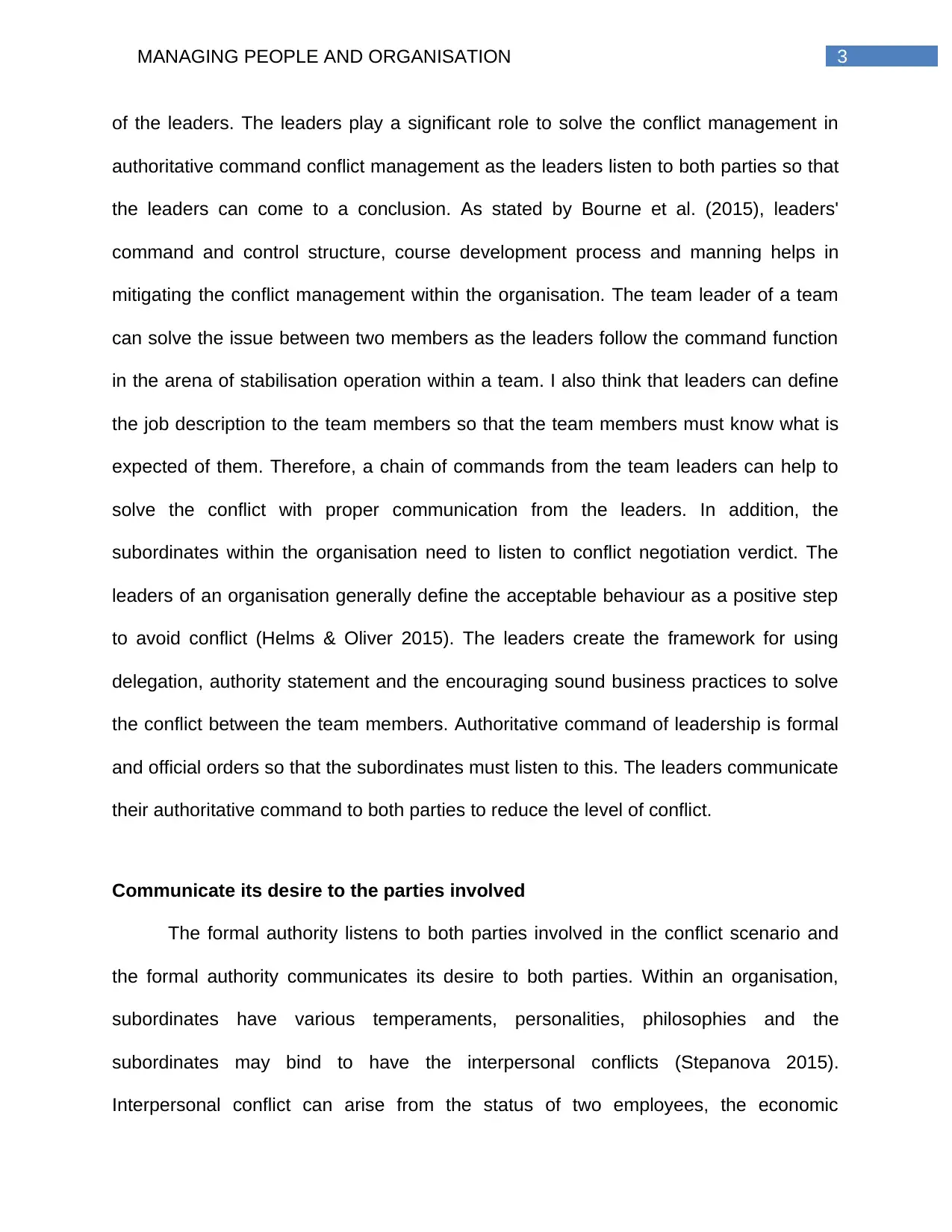
3MANAGING PEOPLE AND ORGANISATION
of the leaders. The leaders play a significant role to solve the conflict management in
authoritative command conflict management as the leaders listen to both parties so that
the leaders can come to a conclusion. As stated by Bourne et al. (2015), leaders'
command and control structure, course development process and manning helps in
mitigating the conflict management within the organisation. The team leader of a team
can solve the issue between two members as the leaders follow the command function
in the arena of stabilisation operation within a team. I also think that leaders can define
the job description to the team members so that the team members must know what is
expected of them. Therefore, a chain of commands from the team leaders can help to
solve the conflict with proper communication from the leaders. In addition, the
subordinates within the organisation need to listen to conflict negotiation verdict. The
leaders of an organisation generally define the acceptable behaviour as a positive step
to avoid conflict (Helms & Oliver 2015). The leaders create the framework for using
delegation, authority statement and the encouraging sound business practices to solve
the conflict between the team members. Authoritative command of leadership is formal
and official orders so that the subordinates must listen to this. The leaders communicate
their authoritative command to both parties to reduce the level of conflict.
Communicate its desire to the parties involved
The formal authority listens to both parties involved in the conflict scenario and
the formal authority communicates its desire to both parties. Within an organisation,
subordinates have various temperaments, personalities, philosophies and the
subordinates may bind to have the interpersonal conflicts (Stepanova 2015).
Interpersonal conflict can arise from the status of two employees, the economic
of the leaders. The leaders play a significant role to solve the conflict management in
authoritative command conflict management as the leaders listen to both parties so that
the leaders can come to a conclusion. As stated by Bourne et al. (2015), leaders'
command and control structure, course development process and manning helps in
mitigating the conflict management within the organisation. The team leader of a team
can solve the issue between two members as the leaders follow the command function
in the arena of stabilisation operation within a team. I also think that leaders can define
the job description to the team members so that the team members must know what is
expected of them. Therefore, a chain of commands from the team leaders can help to
solve the conflict with proper communication from the leaders. In addition, the
subordinates within the organisation need to listen to conflict negotiation verdict. The
leaders of an organisation generally define the acceptable behaviour as a positive step
to avoid conflict (Helms & Oliver 2015). The leaders create the framework for using
delegation, authority statement and the encouraging sound business practices to solve
the conflict between the team members. Authoritative command of leadership is formal
and official orders so that the subordinates must listen to this. The leaders communicate
their authoritative command to both parties to reduce the level of conflict.
Communicate its desire to the parties involved
The formal authority listens to both parties involved in the conflict scenario and
the formal authority communicates its desire to both parties. Within an organisation,
subordinates have various temperaments, personalities, philosophies and the
subordinates may bind to have the interpersonal conflicts (Stepanova 2015).
Interpersonal conflict can arise from the status of two employees, the economic
Paraphrase This Document
Need a fresh take? Get an instant paraphrase of this document with our AI Paraphraser
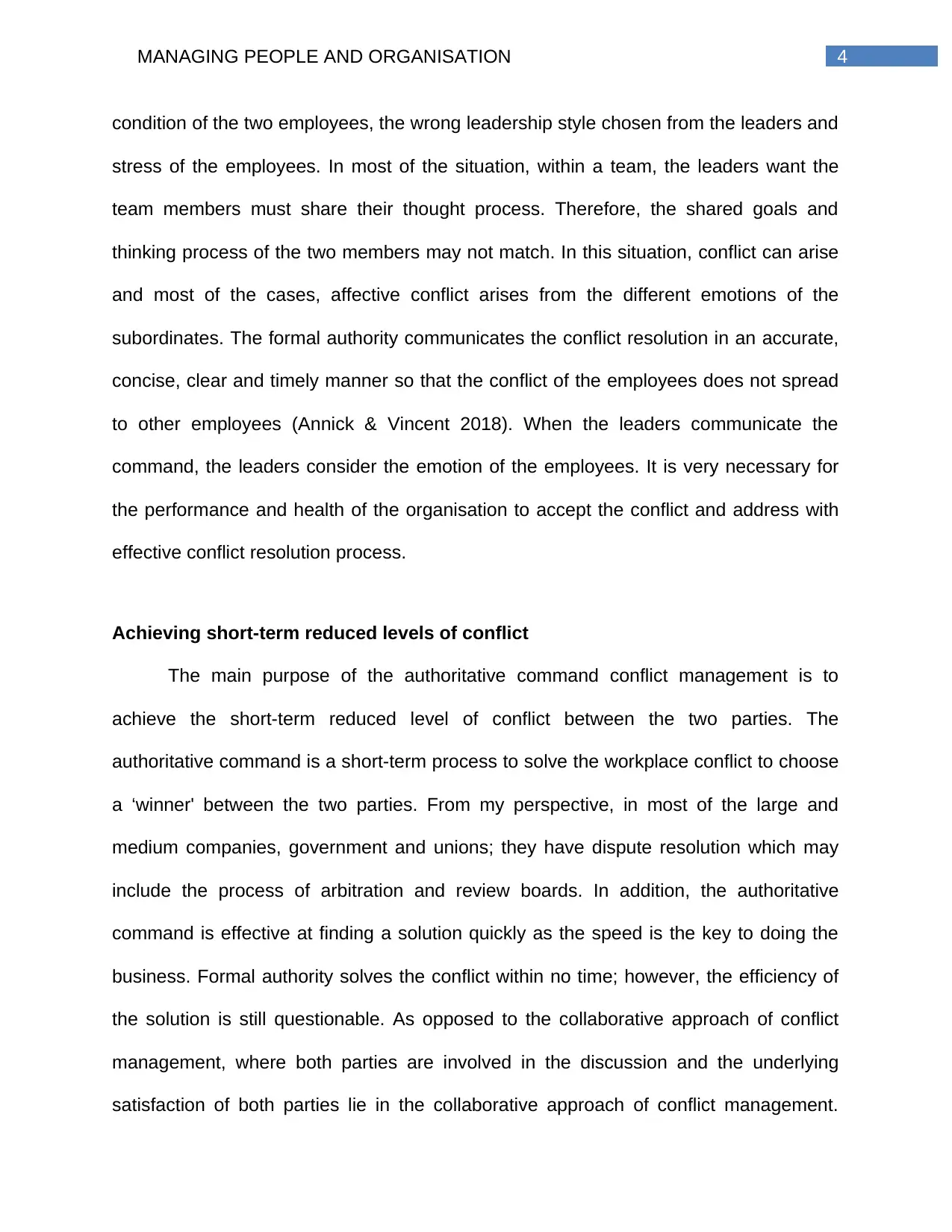
4MANAGING PEOPLE AND ORGANISATION
condition of the two employees, the wrong leadership style chosen from the leaders and
stress of the employees. In most of the situation, within a team, the leaders want the
team members must share their thought process. Therefore, the shared goals and
thinking process of the two members may not match. In this situation, conflict can arise
and most of the cases, affective conflict arises from the different emotions of the
subordinates. The formal authority communicates the conflict resolution in an accurate,
concise, clear and timely manner so that the conflict of the employees does not spread
to other employees (Annick & Vincent 2018). When the leaders communicate the
command, the leaders consider the emotion of the employees. It is very necessary for
the performance and health of the organisation to accept the conflict and address with
effective conflict resolution process.
Achieving short-term reduced levels of conflict
The main purpose of the authoritative command conflict management is to
achieve the short-term reduced level of conflict between the two parties. The
authoritative command is a short-term process to solve the workplace conflict to choose
a ‘winner' between the two parties. From my perspective, in most of the large and
medium companies, government and unions; they have dispute resolution which may
include the process of arbitration and review boards. In addition, the authoritative
command is effective at finding a solution quickly as the speed is the key to doing the
business. Formal authority solves the conflict within no time; however, the efficiency of
the solution is still questionable. As opposed to the collaborative approach of conflict
management, where both parties are involved in the discussion and the underlying
satisfaction of both parties lie in the collaborative approach of conflict management.
condition of the two employees, the wrong leadership style chosen from the leaders and
stress of the employees. In most of the situation, within a team, the leaders want the
team members must share their thought process. Therefore, the shared goals and
thinking process of the two members may not match. In this situation, conflict can arise
and most of the cases, affective conflict arises from the different emotions of the
subordinates. The formal authority communicates the conflict resolution in an accurate,
concise, clear and timely manner so that the conflict of the employees does not spread
to other employees (Annick & Vincent 2018). When the leaders communicate the
command, the leaders consider the emotion of the employees. It is very necessary for
the performance and health of the organisation to accept the conflict and address with
effective conflict resolution process.
Achieving short-term reduced levels of conflict
The main purpose of the authoritative command conflict management is to
achieve the short-term reduced level of conflict between the two parties. The
authoritative command is a short-term process to solve the workplace conflict to choose
a ‘winner' between the two parties. From my perspective, in most of the large and
medium companies, government and unions; they have dispute resolution which may
include the process of arbitration and review boards. In addition, the authoritative
command is effective at finding a solution quickly as the speed is the key to doing the
business. Formal authority solves the conflict within no time; however, the efficiency of
the solution is still questionable. As opposed to the collaborative approach of conflict
management, where both parties are involved in the discussion and the underlying
satisfaction of both parties lie in the collaborative approach of conflict management.
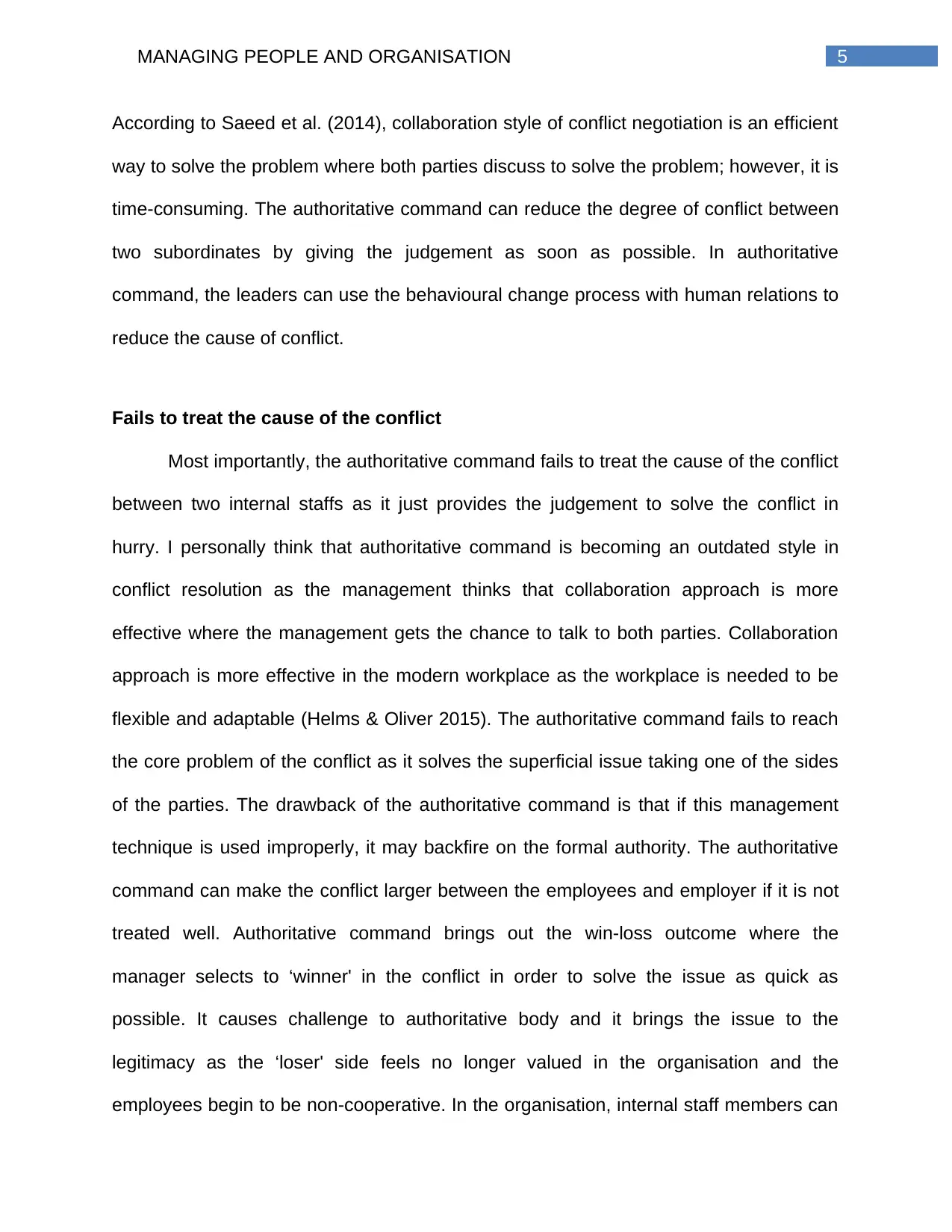
5MANAGING PEOPLE AND ORGANISATION
According to Saeed et al. (2014), collaboration style of conflict negotiation is an efficient
way to solve the problem where both parties discuss to solve the problem; however, it is
time-consuming. The authoritative command can reduce the degree of conflict between
two subordinates by giving the judgement as soon as possible. In authoritative
command, the leaders can use the behavioural change process with human relations to
reduce the cause of conflict.
Fails to treat the cause of the conflict
Most importantly, the authoritative command fails to treat the cause of the conflict
between two internal staffs as it just provides the judgement to solve the conflict in
hurry. I personally think that authoritative command is becoming an outdated style in
conflict resolution as the management thinks that collaboration approach is more
effective where the management gets the chance to talk to both parties. Collaboration
approach is more effective in the modern workplace as the workplace is needed to be
flexible and adaptable (Helms & Oliver 2015). The authoritative command fails to reach
the core problem of the conflict as it solves the superficial issue taking one of the sides
of the parties. The drawback of the authoritative command is that if this management
technique is used improperly, it may backfire on the formal authority. The authoritative
command can make the conflict larger between the employees and employer if it is not
treated well. Authoritative command brings out the win-loss outcome where the
manager selects to ‘winner' in the conflict in order to solve the issue as quick as
possible. It causes challenge to authoritative body and it brings the issue to the
legitimacy as the ‘loser' side feels no longer valued in the organisation and the
employees begin to be non-cooperative. In the organisation, internal staff members can
According to Saeed et al. (2014), collaboration style of conflict negotiation is an efficient
way to solve the problem where both parties discuss to solve the problem; however, it is
time-consuming. The authoritative command can reduce the degree of conflict between
two subordinates by giving the judgement as soon as possible. In authoritative
command, the leaders can use the behavioural change process with human relations to
reduce the cause of conflict.
Fails to treat the cause of the conflict
Most importantly, the authoritative command fails to treat the cause of the conflict
between two internal staffs as it just provides the judgement to solve the conflict in
hurry. I personally think that authoritative command is becoming an outdated style in
conflict resolution as the management thinks that collaboration approach is more
effective where the management gets the chance to talk to both parties. Collaboration
approach is more effective in the modern workplace as the workplace is needed to be
flexible and adaptable (Helms & Oliver 2015). The authoritative command fails to reach
the core problem of the conflict as it solves the superficial issue taking one of the sides
of the parties. The drawback of the authoritative command is that if this management
technique is used improperly, it may backfire on the formal authority. The authoritative
command can make the conflict larger between the employees and employer if it is not
treated well. Authoritative command brings out the win-loss outcome where the
manager selects to ‘winner' in the conflict in order to solve the issue as quick as
possible. It causes challenge to authoritative body and it brings the issue to the
legitimacy as the ‘loser' side feels no longer valued in the organisation and the
employees begin to be non-cooperative. In the organisation, internal staff members can
⊘ This is a preview!⊘
Do you want full access?
Subscribe today to unlock all pages.

Trusted by 1+ million students worldwide
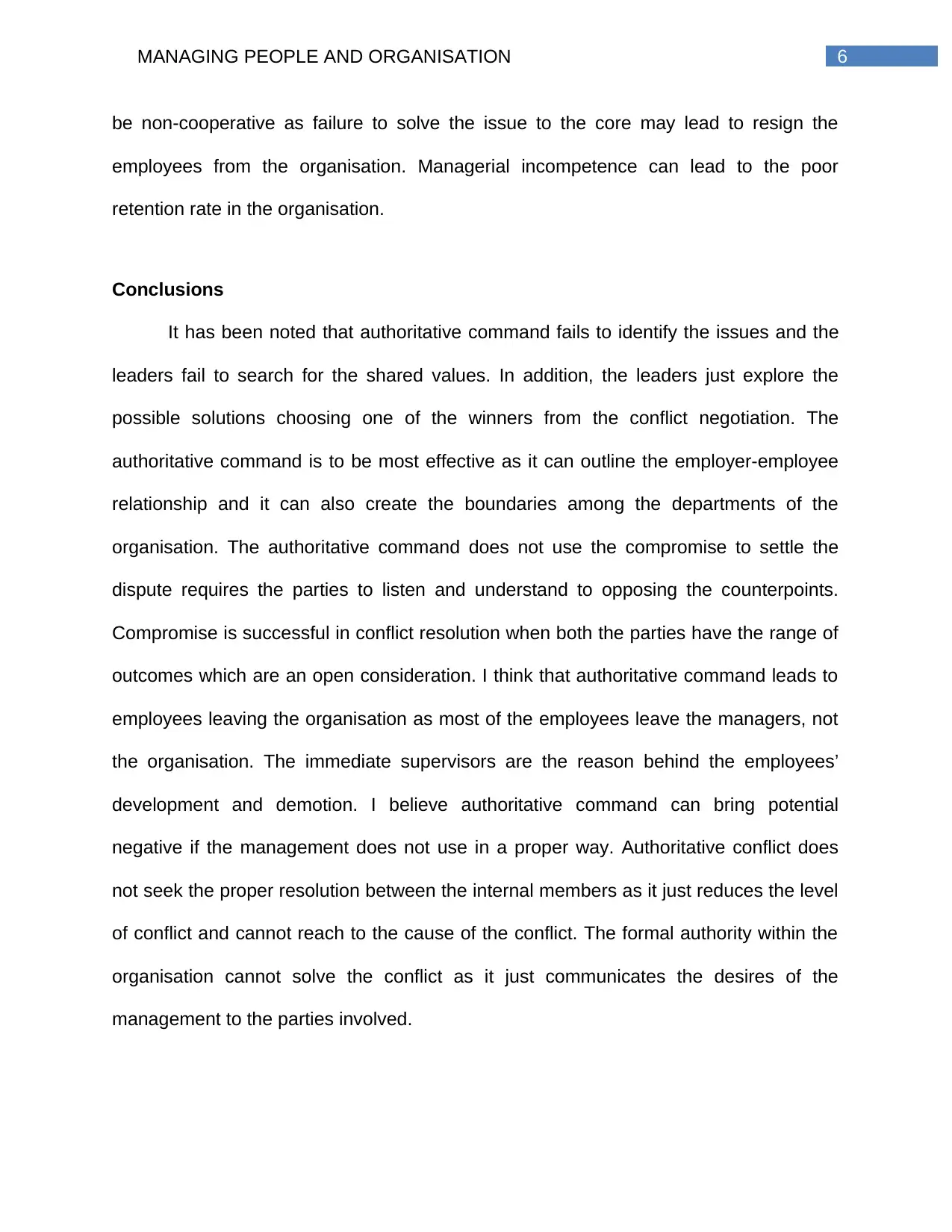
6MANAGING PEOPLE AND ORGANISATION
be non-cooperative as failure to solve the issue to the core may lead to resign the
employees from the organisation. Managerial incompetence can lead to the poor
retention rate in the organisation.
Conclusions
It has been noted that authoritative command fails to identify the issues and the
leaders fail to search for the shared values. In addition, the leaders just explore the
possible solutions choosing one of the winners from the conflict negotiation. The
authoritative command is to be most effective as it can outline the employer-employee
relationship and it can also create the boundaries among the departments of the
organisation. The authoritative command does not use the compromise to settle the
dispute requires the parties to listen and understand to opposing the counterpoints.
Compromise is successful in conflict resolution when both the parties have the range of
outcomes which are an open consideration. I think that authoritative command leads to
employees leaving the organisation as most of the employees leave the managers, not
the organisation. The immediate supervisors are the reason behind the employees’
development and demotion. I believe authoritative command can bring potential
negative if the management does not use in a proper way. Authoritative conflict does
not seek the proper resolution between the internal members as it just reduces the level
of conflict and cannot reach to the cause of the conflict. The formal authority within the
organisation cannot solve the conflict as it just communicates the desires of the
management to the parties involved.
be non-cooperative as failure to solve the issue to the core may lead to resign the
employees from the organisation. Managerial incompetence can lead to the poor
retention rate in the organisation.
Conclusions
It has been noted that authoritative command fails to identify the issues and the
leaders fail to search for the shared values. In addition, the leaders just explore the
possible solutions choosing one of the winners from the conflict negotiation. The
authoritative command is to be most effective as it can outline the employer-employee
relationship and it can also create the boundaries among the departments of the
organisation. The authoritative command does not use the compromise to settle the
dispute requires the parties to listen and understand to opposing the counterpoints.
Compromise is successful in conflict resolution when both the parties have the range of
outcomes which are an open consideration. I think that authoritative command leads to
employees leaving the organisation as most of the employees leave the managers, not
the organisation. The immediate supervisors are the reason behind the employees’
development and demotion. I believe authoritative command can bring potential
negative if the management does not use in a proper way. Authoritative conflict does
not seek the proper resolution between the internal members as it just reduces the level
of conflict and cannot reach to the cause of the conflict. The formal authority within the
organisation cannot solve the conflict as it just communicates the desires of the
management to the parties involved.
Paraphrase This Document
Need a fresh take? Get an instant paraphrase of this document with our AI Paraphraser
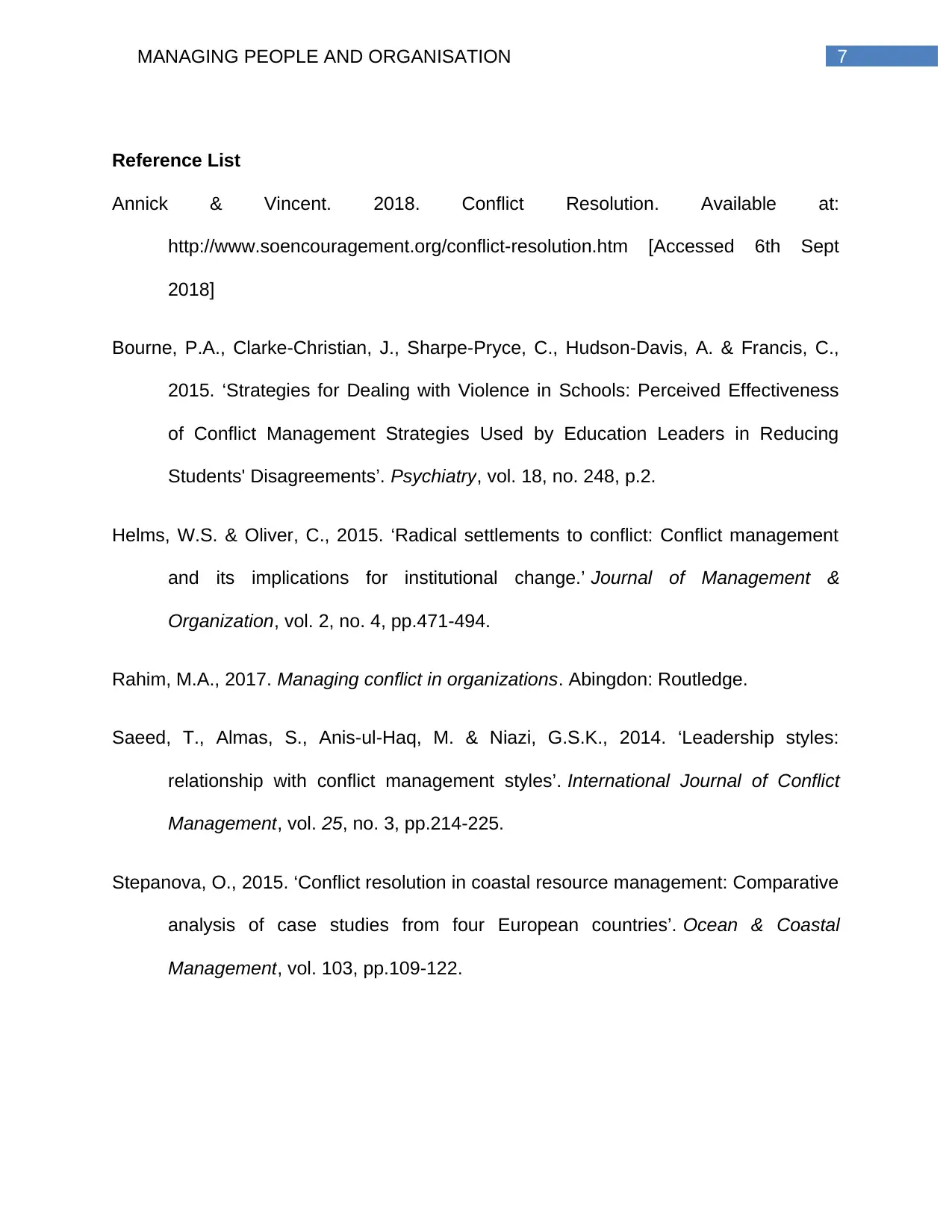
7MANAGING PEOPLE AND ORGANISATION
Reference List
Annick & Vincent. 2018. Conflict Resolution. Available at:
http://www.soencouragement.org/conflict-resolution.htm [Accessed 6th Sept
2018]
Bourne, P.A., Clarke-Christian, J., Sharpe-Pryce, C., Hudson-Davis, A. & Francis, C.,
2015. ‘Strategies for Dealing with Violence in Schools: Perceived Effectiveness
of Conflict Management Strategies Used by Education Leaders in Reducing
Students' Disagreements’. Psychiatry, vol. 18, no. 248, p.2.
Helms, W.S. & Oliver, C., 2015. ‘Radical settlements to conflict: Conflict management
and its implications for institutional change.’ Journal of Management &
Organization, vol. 2, no. 4, pp.471-494.
Rahim, M.A., 2017. Managing conflict in organizations. Abingdon: Routledge.
Saeed, T., Almas, S., Anis-ul-Haq, M. & Niazi, G.S.K., 2014. ‘Leadership styles:
relationship with conflict management styles’. International Journal of Conflict
Management, vol. 25, no. 3, pp.214-225.
Stepanova, O., 2015. ‘Conflict resolution in coastal resource management: Comparative
analysis of case studies from four European countries’. Ocean & Coastal
Management, vol. 103, pp.109-122.
Reference List
Annick & Vincent. 2018. Conflict Resolution. Available at:
http://www.soencouragement.org/conflict-resolution.htm [Accessed 6th Sept
2018]
Bourne, P.A., Clarke-Christian, J., Sharpe-Pryce, C., Hudson-Davis, A. & Francis, C.,
2015. ‘Strategies for Dealing with Violence in Schools: Perceived Effectiveness
of Conflict Management Strategies Used by Education Leaders in Reducing
Students' Disagreements’. Psychiatry, vol. 18, no. 248, p.2.
Helms, W.S. & Oliver, C., 2015. ‘Radical settlements to conflict: Conflict management
and its implications for institutional change.’ Journal of Management &
Organization, vol. 2, no. 4, pp.471-494.
Rahim, M.A., 2017. Managing conflict in organizations. Abingdon: Routledge.
Saeed, T., Almas, S., Anis-ul-Haq, M. & Niazi, G.S.K., 2014. ‘Leadership styles:
relationship with conflict management styles’. International Journal of Conflict
Management, vol. 25, no. 3, pp.214-225.
Stepanova, O., 2015. ‘Conflict resolution in coastal resource management: Comparative
analysis of case studies from four European countries’. Ocean & Coastal
Management, vol. 103, pp.109-122.
1 out of 8
Related Documents
Your All-in-One AI-Powered Toolkit for Academic Success.
+13062052269
info@desklib.com
Available 24*7 on WhatsApp / Email
![[object Object]](/_next/static/media/star-bottom.7253800d.svg)
Unlock your academic potential
Copyright © 2020–2025 A2Z Services. All Rights Reserved. Developed and managed by ZUCOL.





